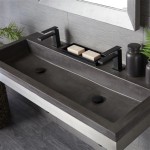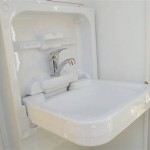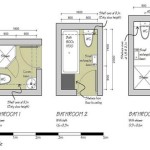Do Large Tiles Look Ok in Small Bathrooms? A Comprehensive Guide
The question of whether large tiles are suitable for small bathrooms is a recurring theme in interior design discussions. Conventional wisdom often dictates that smaller spaces require smaller elements, including tiles, to avoid overwhelming the area. However, modern design principles and advancements in tiling techniques have challenged this notion, suggesting that large tiles can, indeed, work effectively in small bathrooms, and, in some cases, even enhance the perception of space. This article will explore the factors that influence the suitability of large tiles in small bathrooms, providing a detailed analysis of design considerations, installation techniques, and aesthetic implications.
The term "large tiles" is generally understood to refer to tiles exceeding the dimensions of standard sizes, often surpassing 12x24 inches. These tiles can range up to several feet in length and width, commonly found in formats such as 24x48 inches or larger. Their appeal lies in their ability to minimize grout lines, creating a more seamless and visually expansive surface. When considering the application of these tiles in a smaller bathroom, several crucial aspects must be carefully evaluated.
Scale and Proportion in Small Bathrooms
One of the primary concerns when using large tiles in a small bathroom revolves around the principles of scale and proportion. The human eye perceives the size of an object relative to its surroundings. If a large tile is used indiscriminately in a small space without considering the overall dimensions of the room, it can lead to a feeling of imbalance or claustrophobia. The key is to select a tile size that is large enough to offer the benefits of reduced grout lines but not so large that it dwarfs the room. A good starting point is to measure the dimensions of the bathroom and visualize how the selected tile size will fit within the existing layout.
Furthermore, the placement of large tiles is crucial. Using large tiles on both the floor and walls can create a unified look that makes the space feel larger. However, it is vital to ensure that the tiles are properly aligned and spaced to avoid awkward cuts or an overly busy appearance. In some instances, using large tiles on the floor and smaller tiles on the walls, or vice versa, can create visual interest while maintaining an appropriate sense of scale. The strategic use of grout color can also significantly impact the perceived size and proportion of the tiles. A grout color that closely matches the tile color will further minimize the appearance of grout lines, enhancing the seamless effect.
Another tactic to consider is using large tiles in a specific area of the bathroom, such as the shower enclosure. This can create a focal point and add visual interest without overwhelming the entire space. The selection of lighting also plays a critical role in how the tiles are perceived. Well-placed lighting can highlight the texture and color of the tiles, enhancing their aesthetic appeal and contributing to a sense of spaciousness. Conversely, poor lighting can accentuate any imperfections or make the space feel even smaller.
The Impact of Grout Lines on Visual Perception
The reduction of grout lines is often cited as a major advantage of using large tiles. Grout lines act as visual interruptions, breaking up the surface and potentially making a space appear smaller and busier. By minimizing the number of grout lines, large tiles contribute to a cleaner, more streamlined aesthetic. This seamless effect can create the illusion of more space, as the eye is not distracted by numerous intersecting lines.
However, the quality of the grout and its application are paramount. Poorly applied grout or grout that is stained or discolored can detract from the overall appearance of the tiles, regardless of their size. It is essential to use high-quality grout and to ensure that it is properly sealed to prevent staining and discoloration. Epoxy grout is often recommended for bathrooms due to its superior resistance to water, stains, and mold. Regular maintenance and cleaning of the grout are also crucial to preserving its appearance and preventing the buildup of dirt and grime.
Furthermore, the color of the grout can significantly impact the visual effect. As mentioned previously, using a grout color that closely matches the tile color will minimize the appearance of grout lines and enhance the seamless effect. Conversely, using a contrasting grout color will accentuate the grout lines, potentially making the space appear smaller and busier. The choice of grout color should be carefully considered in relation to the overall design aesthetic and the desired effect on the perceived size of the bathroom.
In addition to color, the width of the grout lines can also be adjusted to achieve the desired visual effect. Narrow grout lines will further minimize their appearance, contributing to a cleaner and more seamless look. Wide grout lines, on the other hand, can add texture and visual interest, but they should be used sparingly in small bathrooms to avoid overwhelming the space. The choice of grout width should be carefully balanced with the overall design goals and the specific characteristics of the tiles being used.
Installation Considerations for Large Tiles in Small Bathrooms
The successful installation of large tiles in a small bathroom requires careful planning and execution. Due to the size and weight of these tiles, the substrate must be perfectly level and structurally sound to prevent cracking or unevenness. A self-leveling underlayment may be necessary to create a smooth and even surface for the tiles to adhere to. The use of a high-quality adhesive is also essential to ensure proper bonding and prevent the tiles from shifting or detaching over time.
Cutting large tiles to fit around fixtures and corners can be challenging, requiring specialized tools and techniques. A wet saw with a diamond blade is typically used to make precise cuts without chipping or damaging the tiles. It is also important to plan the layout carefully to minimize the number of cuts required and to ensure that the cuts are strategically placed to avoid awkward or unsightly edges. The services of a professional tile installer are highly recommended, especially for complex installations or when working with expensive or delicate tiles.
Furthermore, access to the small bathroom can pose logistical challenges during the installation process. Large tiles can be difficult to maneuver in tight spaces, and extra care must be taken to avoid damaging walls or fixtures. Adequate ventilation is also important to ensure that the adhesive and grout dry properly. The installation process may take longer than with smaller tiles, and it is essential to allow sufficient time for each step to be completed correctly.
Another important consideration is the thickness of the tiles. Thicker tiles are generally more durable and resistant to cracking, but they can also add weight to the floor and walls. It is important to ensure that the substrate can support the weight of the tiles and that the additional thickness does not create any issues with door clearances or transitions to other flooring materials. The weight and thickness of the tiles should be carefully considered in relation to the overall structural integrity of the bathroom.
Finally, the placement of drains and plumbing fixtures must be carefully planned in relation to the tile layout. It is important to ensure that the tiles are properly sloped to allow for adequate drainage and to avoid water pooling. The placement of fixtures such as toilets and sinks should be carefully considered to minimize the need for complex cuts and to ensure that the tiles are aesthetically pleasing and functional. A well-planned layout will not only enhance the appearance of the bathroom but also ensure that it is practical and easy to use.
In summation, while the use of large tiles in small bathrooms presents unique challenges, it can be a successful design strategy when implemented thoughtfully and skillfully. Considerations of scale, grout lines, and installation techniques are paramount. By carefully evaluating these factors, it is possible to create a bathroom that is both visually appealing and functionally efficient, demonstrating that large tiles can indeed look ok, and even exceptional, in small bathrooms.

How To Make A Small Bathroom Look Bigger With Tiles Roccia

Big Tile Or Little How To Design For Small Bathrooms And Living Spaces S Of America

Tiles Talk Find The Right Size For A Small Bathroom

Tiles Talk Find The Right Size For A Small Bathroom

Big Tile Or Little How To Design For Small Bathrooms And Living Spaces S Of America

19 Tricks To Make A Small Bathroom Look Bigger First Choice Warehouse

Big Tile Or Little How To Design For Small Bathrooms And Living Spaces S Of America

19 Tricks To Make A Small Bathroom Look Bigger First Choice Warehouse

Big Tile Or Little How To Design For Small Bathrooms And Living Spaces S Of America

What Size Tile Should I Use In A Small Bathroom Warehouse
Related Posts







